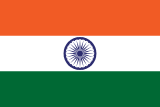
India
General Elections, April-June 2024
Heatwave, March–June 2024
A deadly heatwave swept across India during March–June 2024 in the pre-monsoon season , initially spreading over the Western states before eventually reaching the Northern parts of the country (Pradhan 2024). Many places reported record temperatures, including Delhi with temperatures as high as 52.9 degrees Celsius (Adil 2024). According to studies reviewed by World Weather Attribution, human-induced climate change made heatwaves in the region and season 30 times more likely and much hotter. over the preceding two years (WWA 2024). A steep increase in the use of air conditioning and refrigeration meant that India’s electric grid reached a record load of 250 million kilowatts on 30 May 2024; improved capacity averted any blackouts during the elections (Kemp 2024).
Studies reviewed by World Weather Attribution suggest that human-induced climate change made South Asia’s heatwaves in this season 30 times more likely and ‘much hotter’ over the preceding two years (WWA 2024). According to the Intergovernmental Panel on Climate Change, more intense heatwaves and future floods are projected across India; Himachal Pradesh, Bihar and Odisha are among the states most prone to natural hazards (Ambarkhane 2024).
Impact on the electoral process
The general elections were held in India between April and June 2024. Campaigning was impacted by the heatwave with political parties shifting their campaign efforts to early mornings/evenings (Pradhan 2024); Roads Minister Nitin Gadkari fainted while giving a speech (AFP). At least 33 poll workers died in a single day in Uttar Pradesh (Mitra 2024; Adil 2024), 10 polling personnel died from heatstroke in Bihar and three more died in Rohtas (PTI 2024b). This led to dissatisfaction amongst poll workers about the level of care provided by the Election Commission of India (ECI) (Tripathi 2024) and to public debate about the timing of the election.
According to some politicians, the heatwave may have also had an impact on voter turnout. According to Defence Minister Ranjath Singh, the high temperatures were partly to blame for the low voter turnout in the first four phases in the election (Pradhan 2024). Polling stations were reported to be unusually empty on the second last day of counting in Delhi (Mitra 2024). The exact impact on voter turnout is difficult to measure, however, as competing projections are still estimates.
The National Disaster Management Authority issued a list of Do’s and Don’ts for the population, focusing on how to avoid and to treat heatstroke. The Electoral Commission also issued regulations to address the impacts of the heatwave at polling stations. These included policies mandating the provision of drinking water, shade and medical kits at polling stations (ECI 2024a; 2023). In some polling stations, such as those in Delhi, mist fans and air coolers were also provided (PTI 2024a). Provisions were made to collect votes from senior citizens and differently abled persons. This was done through a vote-from-home service (mobile ballot box voting) run by the EIC for individuals aged over 85 and those with over 40 per cent benchmark disability (ECI 2024b).
Overall voter turnout was 65.79 per cent, as compared with 67.4 per cent in the 2019 elections (International IDEA n.d.)
Adil, A., ‘Heat wave killed 33 poll staffers on last day of Indian elections, say officials’, AA, 2 June 2024, <https://www.aa.com.tr/en/asia-pacific/heat-wave-killed-33-poll-staffers-on-last-day-of-indian-elections-say-officials/3238019>, accessed 9 October 2025
Agence France Presse (AFP), ‘Indian Minister Blames Heat After Fainting At Election Rally’, Barron’s, 25 April 2024, <https://www.barrons.com/news/indian-minister-blames-heat-after-fainting-at-election-rally-ae6e81c7>, accessed 9 October 2025
Ambarkhane, S., Natural Hazards and Elections in India: Lessons in Adaptation and Mitigation (Stockholm: International IDEA, 2024), <https://doi.org/10.31752/idea.2024.4>
Election Commission of India (ECI), ‘General Election to Lok Sabha, 2024 – Advisory on prevention of Heat wave impact’; ‘Assured Minimum Facilities and Other Facilities at Polling Stations’ (No. 464/Meeting/2023/EPS; No. 464/INST-AMF/2022/EPS), 16 March 2024; 10 June 2023, <https://elections24.eci.gov.in/docs/ylOTCbXfik.pdf>, accessed 9 October 2025
—, ‘ECI walks the extra mile to reach at the doorstep of elderly and PwD voters / Citizens above 85 years & PwDs starts voting from home: 18th Lok Sabha Election makes history / Over 1.7 crore 85+ Voters and Persons with Disabilities (PwD) voters can avail facility’, <https://www.pib.gov.in/PressReleaseIframePage.aspx?PRID=2017764>, accessed 9 October 2025
International IDEA, Voter Turnout Database – ‘India’, [n.d.], <https://www.idea.int/data-tools/data/country?country=103&database_theme=293>, accessed 9 October 2025
Kemp, J., ‘India runs power plants flat out to keep cool in heatwave and election’, Reuters, 3 June 2024, <https://www.reuters.com/world/india/india-runs-power-plants-flat-out-keep-cool-heatwave-election-kemp-2024-05-31/>, accessed 9 October 2025
Mitra, E., ‘Dozens killed by extreme heat in India as polls close in world’s largest election’, CNN, 3 June 2024, <https://www.cnn.com/2024/06/02/india/india-heatwave-poll-worker-deaths-intl-hnk/index.html>, accessed 9 October 2025
Pradhan, B., ‘“Unbearable”: Will 45C heatwaves affect who India chooses in election?’, Al Jazeera, 14 May 2024, <https://www.aljazeera.com/news/2024/5/14/india-election-will-a-forty-five-degree-heat-wave-affect-who-voters-choose>, accessed 9 October 2025
Press Trust of India (PTI), ‘Air coolers, fans at polling stations in Punjab amid prediction of extreme heat’, The Hindu, 9 April 2024a, <https://www.thehindu.com/elections/lok-sabha/air-coolers-fans-at-polling-stations-in-punjab-amid-prediction-of-extreme-heat/article68046487.ece>, accessed 9 October 2025
—, ‘At least 25 poll staff among 40 hear-related deaths as north India boils’, The Hindu, 31 May 2024b, <https://www.thehindu.com/news/national/poll-staff-among-heat-related-deaths-in-india/article68237124.ece>, accessed 9 October 2025
Tripathi, B., ‘“My body and phones gave up”: covering India’s heatwave election’, Context, 5 June 2024, <https://www.context.news/climate-risks/my-body-and-phones-gave-up-covering-indias-heatwave-election>, accessed 9 October 2025
World Weather Attribution (WWA), ‘Climate change made the deadly heatwaves that hit millions of highly vulnerable people across Asia more frequent and extreme’, 14 May 2024, <https://www.worldweatherattribution.org/climate-change-made-the-deadly-heatwaves-that-hit-millions-of-highly-vulnerable-people-across-asia-more-frequent-and-extreme/ >, accessed 9 October 2025